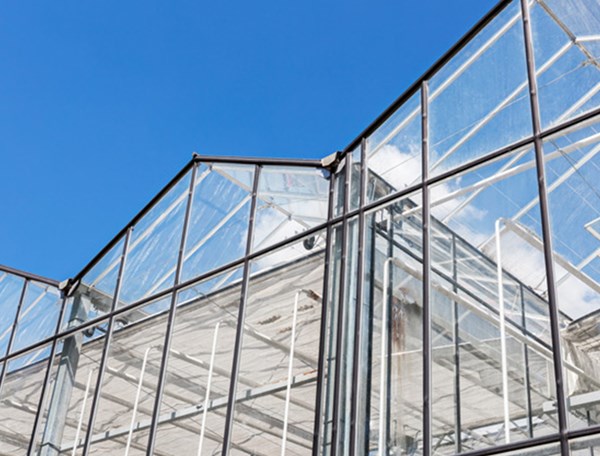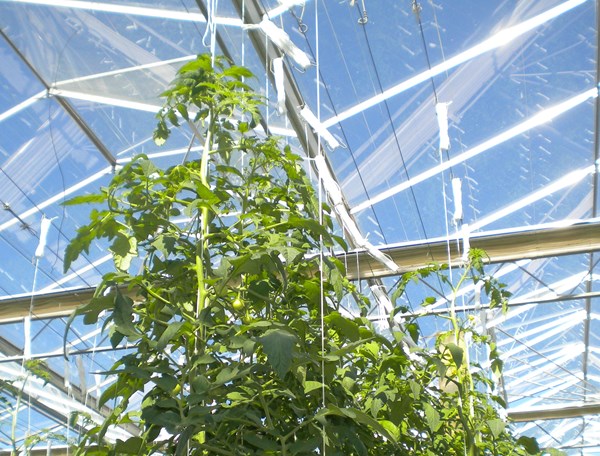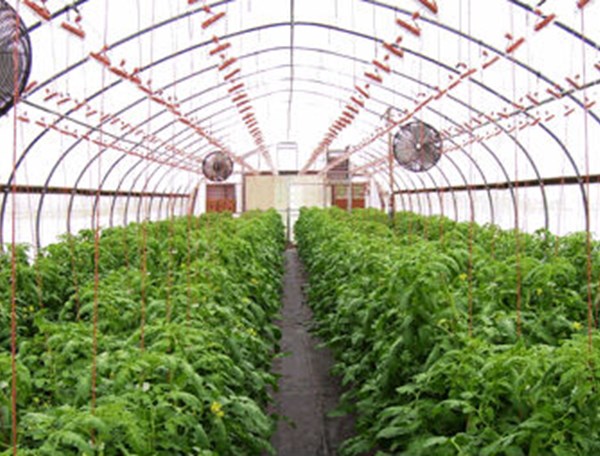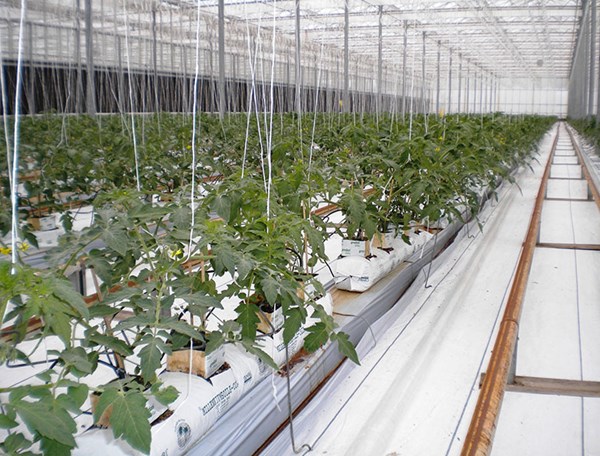Training Center
Tips for Efficient Energy Conservation in a Greenhouse
Thursday, September 7, 2023 | Jose Chen Lopez
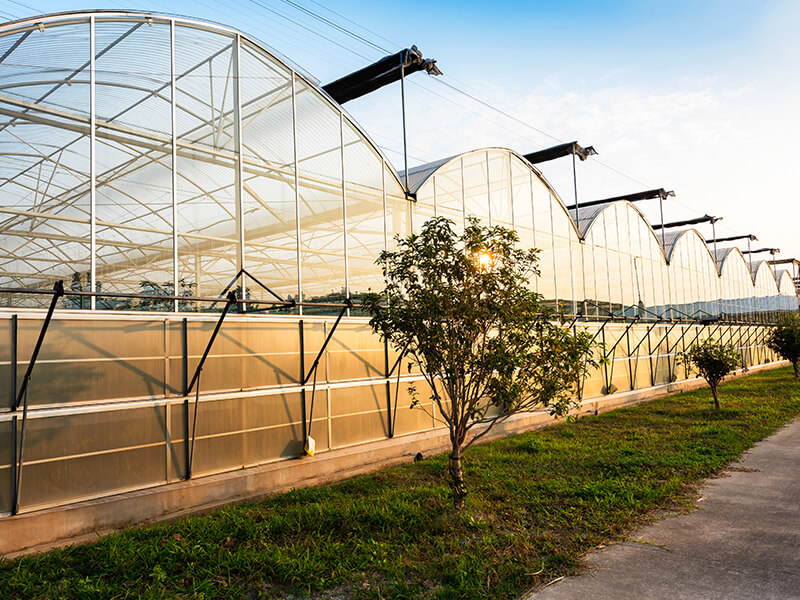
As the fall approaches, the days get shorter and shorter. This is the time of the year where our free energy source, sunlight, becomes limited. Sunlight is essential to maintain the global temperature in the ranges appropriate for plant growth. In winter, plant production is challenging because temperature and solar radiation decline to their minimum values.
In addition, there are several cloudy days which further diminish photosynthesis. Nevertheless, greenhouses are designed to minimize the negative effects of those environmental constraints. As winter approaches, the need for heating increases. The energy consumed to heat a greenhouse can be as high as 80% of the total energy required to run a greenhouse business.
Greenhouse location
Starting in summer, the day length decreases as latitude increases. For example, on December 21stthe day length in New York (Latitude: 40˚N) is 9 hours and 15 minutes and the solar radiation for a sunny day would be 1555 J/cm2 during this day. On the other hand, in Queretaro, Mexico (Latitude: 20˚ 35’ N), for the same day, the day length is 10 hours 53 minutes, solar radiation for a sunny day would be 2783 J/cm2 during this day.
There is almost twice the amount of solar radiation energy received in Queretaro, Mexico, than in New York, and as a result we can expect lower temperatures and greater heating costs in New York than in Queretaro.
The heat loss or gain in a greenhouse occurs in 4 different ways: conduction, convection, radiation and infiltration.
- Conduction occurs when heat is transferred between two bodies in direct contact.
- Convection occurs when the heat is transferred via a fluid like water or air to the surface of an object.
- Radiation occurs when the heat is transferred without any physical contact or with the help of a fluid (e.g. solar radiation).
- Infiltration occurs when there is an exchange or leakage of air between the inside and the outside.
In order to fully understand the different ways to save energy for heating, it is essential to study how to conserve energy. Here are some strategies:
Planning Greenhouse Orientation by Type: Single-Bay and Gutter-Connected
In order to produce crops in the winter months in northern latitudes above 40˚N, a single-bay greenhouse should be oriented east-west, but the rows have to be oriented north-south to minimize shading. Gutter-connected greenhouses and plant rows must be oriented north-south.
Choosing the Right Covering: Single-Layer vs. Double-Layer
It is a fact that single-layer coverings lose more heat than double-layer coverings. Each covering material has different heat transfer values. In greenhouse agriculture, the units used to measure the amount of energy to heat or cool a pound of water by one degree Fahrenheit is called the “British Thermal Unit” (BTU). To demonstrate the energy loss differences, let’s assume there are two greenhouses: one with single-layer polyethylene and another with double-layer polyethylene.
The outside temperature is 20˚F (-7˚C) and the inside is maintained at 60˚F (16˚C) during the night. The energy loss through the single-layer polyethylene would be 335,000 BTUs, but for the double-layer polyethylene, it would be 200,000 BTUs. By using polyethylene with infrared barrier and anti-condensation surface treatment, heat loss can be further reduced.
Choosing the Right Covering: Heat Loss Coefficients
The greenhouse coverings have different heat loss coefficients. For example, by reusing the above parameters, the heat loss for a greenhouse covered with an 8mm twin wall polycarbonate would be 183,000 BTUs. The savings would be 45% and 9% compared with a single-layer polyethylene and a double-layer polyethylene, respectively.
Selecting Greenhouse Type Based on Heat Loss: Single-Bay vs. Gutter-Connected
A single-bay greenhouse will lose more heat than a gutter-connected greenhouse because the single-bay greenhouse will have more surface area exposed to the outdoors. For example, if there are three greenhouses similar as the above greenhouse, the heat loss for a single-layer polyethylene would be 335,000 BTUs times three single-bay greenhouses equals 1,005,000 BTUs of energy loss. On the other hand, if those three greenhouses are gutter-connected, the heat loss would be 785,000 BTUs, or 22% less than the three single-bay greenhouses.
Properly Insulating the Greenhouse
Insulation materials can be placed at the base of the walls of the greenhouse (even below the surface of the soil) up to the plant height. The insulation material can be as simple as extruded polystyrene.
Limiting Air Infiltration or Leakage
The infiltration rate for a greenhouse is measured as air exchanges per hour. A new greenhouse with glass covering will have 1.5 times the amount of air exchange per hour when compared to a double-layer polyethylene film. An “old construction” glass greenhouse in good condition typically has twice the amount of air exchange per hour compared to a new glass covered greenhouse and four times more if the “old construction” glass greenhouse is in poor condition. It is impossible to avoid infiltration, but it is possible to minimize it by sealing holes to the outside and by tightly closing vents, louvers and doors.
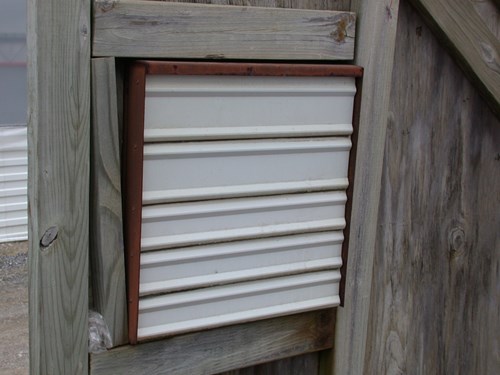
Poorly sealed vent louvers can cause significant air infiltration and heat loss. Source: Premier Tech
Using Windbreaks
It is recommended to install windbreaks around the greenhouse facility. The windbreaks can be conifers or evergreen trees, although with anything that is used, they must be placed at a certain distance to avoid shadows especially during winter on the south side. The windbreaks serve as a physical barrier for the wind, decreasing air velocity and subsequent air infiltration.
Using Energy Blankets or Curtains
On a clear night, heat energy is lost rapidly from the earth into space via long-wavelength radiation. On the other hand, energy loss diminishes during a cloudy night because the clouds trap long-wavelength radiation, serving as a natural blanket. Likewise, energy blankets or curtains installed in greenhouses serve to reduce heat loss at night. They are installed just below the gutter and are retractable so they can be closed during the night and retracted during the day. When closed, there is less volume of air to heat and the long-wavelength radiation bounces back to the leaves of the plants and other surfaces. During summer, the energy blanket can serve as a shade, thus decreasing the heat load in the greenhouse. Energy curtains are often made from aluminized polyester and, depending on how they are woven, may be porous, semi-porous or impervious to moisture.
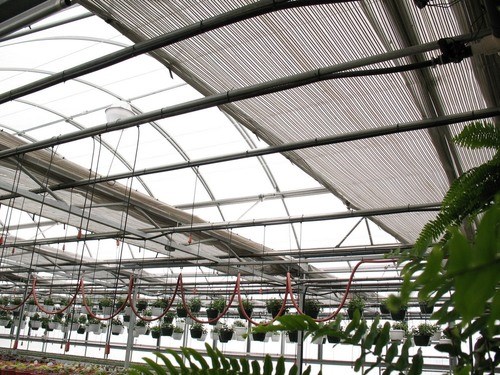
Partially retracted shade curtain will help keep heat in the greenhouse at night. Source: Premier Tech
Maintaining Temperature Sensors and Thermostats
It is important to do routine maintenance and calibration of temperature sensors and/or thermostats. When the temperature sensors do not read the appropriate air temperature, the heating system may run too long or too often, or not heat sufficiently when required. A heating system that does not work frequently enough when the temperature is too cold can slow down the development of plants and promote insect or disease problems. On the other hand, when the heater is running too often, the extra heat generated is often not cost-effective and is therefore wasted. The temperature sensors must cover the entire greenhouse area in order to have a better heating efficiency.
All the tips listed above are aimed at making your greenhouse more energy efficient. Although it is easier to save energy if the greenhouse is properly designed from the beginning, making a few changes may be worthwhile for the planet, and they will definitely be good for you and your crops. Since saving energy also means saving money!
To learn more about best practices for heating a greenhouse, read this: Heating Systems for a Temperate Greenhouse
For more information, contact your Premier Tech Grower Services Representative.
 |
 |
 |
 |
|---|---|---|---|
|
Ed Bloodnick |
Nathan Wallace-Springer |
Lance Lawson |
Victor Brantly |
 |
 |
 |
|
|
Troy Buechel |
Susan Parent |
Jose Chen Lopez |
PRO-MIX® is a registered trademark of PREMIER HORTICULTURE Ltd.
Related Articles
-
Greenhouse Sanitation: Preparing For A Successful Season
As the old saying goes, “an ounce of prevention is worth a pound of cure”. The cost of greenhouse sanitation is minimal in comparison to the costs associated with fixing problems, such as weeding and chemical pest control.
-
Greenhouse Herb and Vegetable Production – Part 2/4 – Greenhouse Structure
In this second part of our four-part series on growing vegetables and herbs in the greenhouse, we will focus on the greenhouse structures needed to produce quality crops.
-
Greenhouse Herb and Vegetable Production – Part 3/4 – Greenhouse Environment
In this third part of our series on growing greenhouse vegetables and herbs we will focus on the ideal greenhouse environment.
-
Greenhouse Herb and Vegetable Production – Part 4/4 – Growing Media
In this fourth and last part of our series on growing greenhouse vegetables and herbs, we will address the appropriate growing medium to use.

 Where to find our products
Where to find our products
